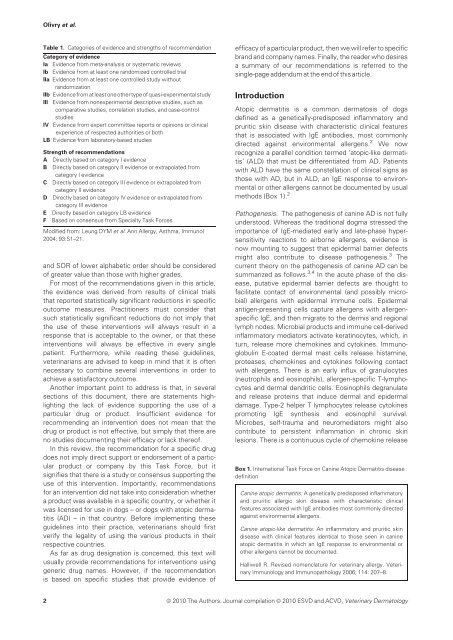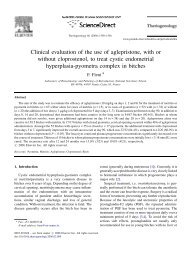Treatment of canine atopic dermatitis: 2010 clinical practice ...
Treatment of canine atopic dermatitis: 2010 clinical practice ...
Treatment of canine atopic dermatitis: 2010 clinical practice ...
Create successful ePaper yourself
Turn your PDF publications into a flip-book with our unique Google optimized e-Paper software.
Olivry et al.<br />
Table 1. Categories <strong>of</strong> evidence and strengths <strong>of</strong> recommendation<br />
Category <strong>of</strong> evidence<br />
Ia Evidence from meta-analysis or systematic reviews<br />
Ib Evidence from at least one randomized controlled trial<br />
IIa Evidence from at least one controlled study without<br />
randomization<br />
IIb Evidencefrom atleast oneothertype <strong>of</strong>quasi-experimental study<br />
III Evidence from nonexperimental descriptive studies, such as<br />
comparative studies, correlation studies, and case-control<br />
studies<br />
IV Evidence from expert committee reports or opinions or <strong>clinical</strong><br />
experience <strong>of</strong> respected authorities or both<br />
LB Evidence from laboratory-based studies<br />
Strength <strong>of</strong> recommendations<br />
A Directly based on category I evidence<br />
B Directly based on category II evidence or extrapolated from<br />
category I evidence<br />
C Directly based on category III evidence or extrapolated from<br />
category II evidence<br />
D Directly based on category IV evidence or extrapolated from<br />
category III evidence<br />
E Directly based on category LB evidence<br />
F Based on consensus from Specialty Task Forces<br />
Modified from: Leung DYM et al. Ann Allergy, Asthma, Immunol<br />
2004; 93:S1–21.<br />
and SOR <strong>of</strong> lower alphabetic order should be considered<br />
<strong>of</strong> greater value than those with higher grades.<br />
For most <strong>of</strong> the recommendations given in this article,<br />
the evidence was derived from results <strong>of</strong> <strong>clinical</strong> trials<br />
that reported statistically significant reductions in specific<br />
outcome measures. Practitioners must consider that<br />
such statistically significant reductions do not imply that<br />
the use <strong>of</strong> these interventions will always result in a<br />
response that is acceptable to the owner, or that these<br />
interventions will always be effective in every single<br />
patient. Furthermore, while reading these guidelines,<br />
veterinarians are advised to keep in mind that it is <strong>of</strong>ten<br />
necessary to combine several interventions in order to<br />
achieve a satisfactory outcome.<br />
Another important point to address is that, in several<br />
sections <strong>of</strong> this document, there are statements highlighting<br />
the lack <strong>of</strong> evidence supporting the use <strong>of</strong> a<br />
particular drug or product. Insufficient evidence for<br />
recommending an intervention does not mean that the<br />
drug or product is not effective, but simply that there are<br />
no studies documenting their efficacy or lack there<strong>of</strong>.<br />
In this review, the recommendation for a specific drug<br />
does not imply direct support or endorsement <strong>of</strong> a particular<br />
product or company by this Task Force, but it<br />
signifies that there is a study or consensus supporting the<br />
use <strong>of</strong> this intervention. Importantly, recommendations<br />
for an intervention did not take into consideration whether<br />
a product was available in a specific country, or whether it<br />
was licensed for use in dogs – or dogs with <strong>atopic</strong> <strong>dermatitis</strong><br />
(AD) – in that country. Before implementing these<br />
guidelines into their <strong>practice</strong>, veterinarians should first<br />
verify the legality <strong>of</strong> using the various products in their<br />
respective countries.<br />
As far as drug designation is concerned, this text will<br />
usually provide recommendations for interventions using<br />
generic drug names. However, if the recommendation<br />
is based on specific studies that provide evidence <strong>of</strong><br />
efficacy <strong>of</strong> a particular product, then we will refer to specific<br />
brand and company names. Finally, the reader who desires<br />
a summary <strong>of</strong> our recommendations is referred to the<br />
single-page addendum at the end <strong>of</strong> this article.<br />
Introduction<br />
Atopic <strong>dermatitis</strong> is a common dermatosis <strong>of</strong> dogs<br />
defined as a genetically-predisposed inflammatory and<br />
pruritic skin disease with characteristic <strong>clinical</strong> features<br />
that is associated with IgE antibodies, most commonly<br />
directed against environmental allergens. 2 We now<br />
recognize a parallel condition termed ‘<strong>atopic</strong>-like <strong>dermatitis</strong>’<br />
(ALD) that must be differentiated from AD. Patients<br />
with ALD have the same constellation <strong>of</strong> <strong>clinical</strong> signs as<br />
those with AD, but in ALD, an IgE response to environmental<br />
or other allergens cannot be documented by usual<br />
methods (Box 1). 2<br />
Pathogenesis. The pathogenesis <strong>of</strong> <strong>canine</strong> AD is not fully<br />
understood. Whereas the traditional dogma stressed the<br />
importance <strong>of</strong> IgE-mediated early and late-phase hypersensitivity<br />
reactions to airborne allergens, evidence is<br />
now mounting to suggest that epidermal barrier defects<br />
might also contribute to disease pathogenesis. 3 The<br />
current theory on the pathogenesis <strong>of</strong> <strong>canine</strong> AD can be<br />
summarized as follows. 3,4 In the acute phase <strong>of</strong> the disease,<br />
putative epidermal barrier defects are thought to<br />
facilitate contact <strong>of</strong> environmental (and possibly microbial)<br />
allergens with epidermal immune cells. Epidermal<br />
antigen-presenting cells capture allergens with allergenspecific<br />
IgE, and then migrate to the dermis and regional<br />
lymph nodes. Microbial products and immune cell-derived<br />
inflammatory mediators activate keratinocytes, which, in<br />
turn, release more chemokines and cytokines. Immunoglobulin<br />
E-coated dermal mast cells release histamine,<br />
proteases, chemokines and cytokines following contact<br />
with allergens. There is an early influx <strong>of</strong> granulocytes<br />
(neutrophils and eosinophils), allergen-specific T-lymphocytes<br />
and dermal dendritic cells. Eosinophils degranulate<br />
and release proteins that induce dermal and epidermal<br />
damage. Type-2 helper T lymphocytes release cytokines<br />
promoting IgE synthesis and eosinophil survival.<br />
Microbes, self-trauma and neuromediators might also<br />
contribute to persistent inflammation in chronic skin<br />
lesions. There is a continuous cycle <strong>of</strong> chemokine release<br />
Box 1. International Task Force on Canine Atopic Dermatitis disease<br />
definition<br />
Canine <strong>atopic</strong> <strong>dermatitis</strong>: A genetically predisposed inflammatory<br />
and pruritic allergic skin disease with characteristic <strong>clinical</strong><br />
features associated with IgE antibodies most commonly directed<br />
against environmental allergens.<br />
Canine <strong>atopic</strong>-like <strong>dermatitis</strong>: An inflammatory and pruritic skin<br />
disease with <strong>clinical</strong> features identical to those seen in <strong>canine</strong><br />
<strong>atopic</strong> <strong>dermatitis</strong> in which an IgE response to environmental or<br />
other allergens cannot be documented.<br />
Halliwell R. Revised nomenclature for veterinary allergy. Veterinary<br />
Immunology and Immunopathology 2006; 114: 207–8.<br />
2 ª <strong>2010</strong> The Authors. Journal compilation ª <strong>2010</strong> ESVD and ACVD, Veterinary Dermatology








